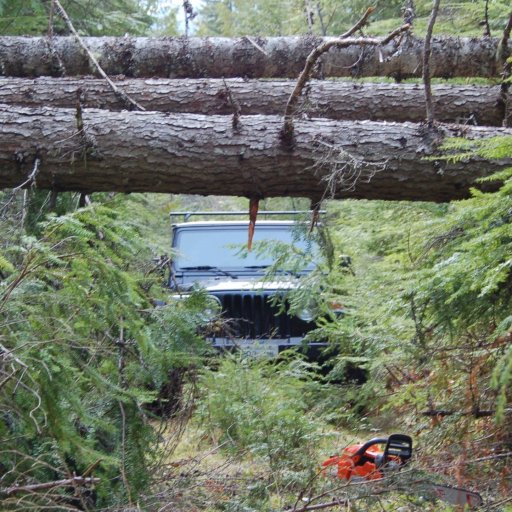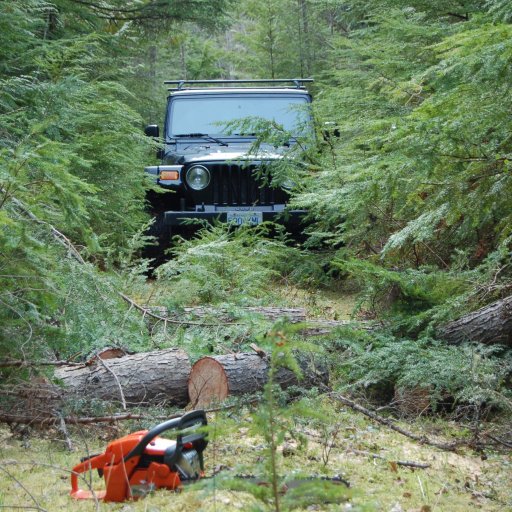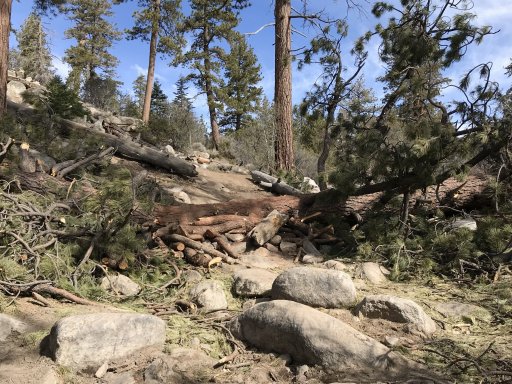When it comes to something like this and you're presented with multiple options, I tend to pick the safest one first. In this case, it's subjective. Which do you have more experience with? Is the downed tree elevated over the road? Lots of variables. Is there another route nearby that lets you bypass?
Fallen trees on the trail
- Thread starter Nickzero
- Start date
Dave K
Rank IV

Off-Road Ranger I

Off-Road Ranger I
I was never aware of this, it's good to know. I use to work for Asplundh tree, so I would just cut the tree into small sections and move it out of the way, OR call my former boss/foreman if the tree was sketchy or under pressure. worse case, we turned around. Trees that are entangled can have a lot of spring pressure on them and can be really dangerous when you release a weight load from them. Not pretty if you're in the way.I almost always carry a $20 permit for woodcutting in the local national forest (valid from early April to early December). This allows me to cut and remove most downed trees (up to 4 cords worth, counted by 1/4 cords) as long as I don't leave designated, open forest service roads. Most National Forests require a permit to cut downed trees, even if they're blocking the road, with the exception that you can do so without a permit if you are literally trapped by the tree. If your choice is to cut the tree or go offroad, they prefer that you cut the tree. If your choice is to take a slightly longer--but still--safe route, they prefer you take the longer route.
BEST ADVICE !!!!!worse case, we turned around.
Trees that are entangled can have a lot of spring pressure on them and can be really dangerous
Not pretty if you're in the way.
before you start a chainsaw, take a chainsaw operation/safety course

Pathfinder I
I owned 2 saws by the time I was 15 and started logging summers at 16.BEST ADVICE !!!!!
before you start a chainsaw, take a chainsaw operation/safety course
I’ve also cleared storm damage for utilities here in Washington and the Oregon coast , along with structural ventilation & wildland for FD.
As a teen the safety training was watch what we do, and don’t be a dumbass. Followed by “hold pressure here, while we get the truck”. So yes if you have never ran a saw I second the “best advice” is get some training. A saw will make hamburger of flesh so fast you won’t realize what just happens.

Enthusiast III

Enthusiast III
I always carry a chainsaw, ax and saw. We came across this little tree-fall earlier this year. We climbed over it initially with our rigs but someone finally cut it out.
Attachments
-
1 MB Views: 48
Boostpowered
Rank VI

Member III
Another thing to think of, if the log is at the start of a trail in the national forrest or even private land it is possible that trail is closed. Check multiple map sources before cutting in this scenario.
The guys I work with take a chainsaw safety course every year. These are professional fallers in the bush every day. The annual course is what makes them professional.I owned 2 saws by the time I was 15 and started logging summers at 16.
I’ve also cleared storm damage for utilities here in Washington and the Oregon coast , along with structural ventilation & wildland for FD.
As a teen the safety training was watch what we do, and don’t be a dumbass. Followed by “hold pressure here, while we get the truck”. So yes if you have never ran a saw I second the “best advice” is get some training. A saw will make hamburger of flesh so fast you won’t realize what just happens.

Advocate III
- 5,584
- First Name
- Michael
- Last Name
- Rose
- Member #
-
20990
- Ham/GMRS Callsign
- W7FSB
- Service Branch
- US ARMY Retired
Dave K
Rank IV

Off-Road Ranger I
Wait. What? Fined? Who’s to say you are properly trained in the safe use of said tools? Is there a law in Oregon that makes clearing a trail obligatory simply because you have tools in your possession? Did you fight this fine?

Advocate III
- 5,584
- First Name
- Michael
- Last Name
- Rose
- Member #
-
20990
- Ham/GMRS Callsign
- W7FSB
- Service Branch
- US ARMY Retired
The ranger knew me... he checked my wood permits almost daily, so ya he knew that I knew my way around a saw, winches, tow straps and the like.... I didnt fight it because it wasnt a huge fine.... and in reality, the reason I didnt open the road that day.... there was still too much slush down lower on that road and opening it up right then would have let the kids in to tear it all up.... I went up a few weeks later and opened the road up when the creek crossing wasnt in slush by just hooking up a strap and dragging the tree to the side of the road.

Advocate III
- 5,584
- First Name
- Michael
- Last Name
- Rose
- Member #
-
20990
- Ham/GMRS Callsign
- W7FSB
- Service Branch
- US ARMY Retired

Off-Road Ranger I
- 2,865
- First Name
- Donald
- Last Name
- Diehl
- Member #
-
0745
- Ham/GMRS Callsign
- WRPN 506
Thank you !! I have always checked with local authorities pre-emptively, just in case there may be a tree laying over the track. I too abhor “convoys”. Wanna get a gate up? Keep running in your convoys. We go alone 99% of the time. When we do go out with others, no more than 3 vehicles. I lead a group of 6 each year for a club event, with permits in a State Forest. I can count on one hand the number of times we’ve not been alone my entire life..Many if not most of the roads we overland on are private roads built by resource companies to access the resource. So even driving on them should require permission. Once you start "logging" on them you definitely need permission.... or turn around. You are on a private road.
If you are on a public road or highway, contact the authority responsible for maintenance.
"Passage of the convoy"..... this is why roads are gated and decommissioned. We sometimes think we have the right to have a private party on public or private land. One of the reasons I prefer to overland alone. So many considerations once you break out the chainsaws. Where will you throw the logs? Into the ditch? Which could/will block the flow of water leading to a wash out and contamination of the drinking water off the watershed?
Best choice, if you do not have permission from the local authority to remove the obstruction, turn around. Look for signage to find out whose road you are on. Notify them. The sense of entitlement that your convoy schedule is your top concern is what leads resource companies to gating or digging a ditch across the road to stop the public from creating a problem.
Boostpowered
Rank VI

Member III
Down south if a trail is closed there is no signs saying so sometimes the mvum wont even reflect it. If a trail is closed it either has a log section purpously placed at the entrance or a pile of dirt or rocks and if you go past that you can get a ticket, we dont have a duty to do anything to fallen logs on the trail. Most of the national forrest ive been to you can get into trouble for cutting anything on the trails especially during fire season. Most of the time when stuff is closed here it is due to contolled burns.

Member III
I wouldn't cut anything at the entrance to a trail - but after I'm a mile or so in if I come across fallen trees I'm taking them out. If they're suspended I lash the lighter side down to something sturdy and put the Husqvarna to work. I'm sure different areas have different rules, but I've actually had a state park in NC list a chainsaw as part of recommended gear when going on the trails. I've actually been about 6 miles into a trail and come across like 5 pines that had fallen across the trail in a bunch as they fell together down a gorge. I put down some safety straps, checked what was down the slope below where the rest of the trees were going to fall and got to work. I had 2 of them cut and looked around. I never even heard the Forestry Service UTV pull up. I never even heard another chain saw start up until I finally let mine idle back down. The guy just gave me a grin, a nod, and then helped me clear the rest. When we were done he shook my hand and thanked me for the help. It was kind of surreal. He said most of the trails are kept to be maintained for fire control or as slide-stops in the wooded gorges we have around here. If you only winch the trees to the sides of the trail it'll effect the flow of water down the hills. Somebody still has to come through to cut that stuff up into smaller sections and kick it on down off the ridge line. Different rules for different places though. South Carolina State Parks it is a huge no-no. North Carolina State Parks encourage it. Most of the National Forests in my general area are fine with it though. As long as you aren't dropping standing trees, cutting stuff on private property, or cutting stuff off trails that aren't marked or blazed - no problems.
That is how it ought to be.I've actually been about 6 miles into a trail and come across like 5 pines that had fallen across the trail in a bunch as they fell together down a gorge. I put down some safety straps, checked what was down the slope below where the rest of the trees were going to fall and got to work. I had 2 of them cut and looked around. I never even heard the Forestry Service UTV pull up. I never even heard another chain saw start up until I finally let mine idle back down. The guy just gave me a grin, a nod, and then helped me clear the rest. When we were done he shook my hand and thanked me for the help.
There are some excellent battery chainsaws available. No reason to annoy everything within a 1/2 mile of our location. No fuel to carry and leak. No fire hazard. Extremely quiet compared to gas.
Most we’ve cleared in one day is 12 trees blocking the route in the National forest. Great for cutting up firewood from the fallen trees around a campsite.
Always safety first.
Most we’ve cleared in one day is 12 trees blocking the route in the National forest. Great for cutting up firewood from the fallen trees around a campsite.
Always safety first.





